Zero-Shot Learning
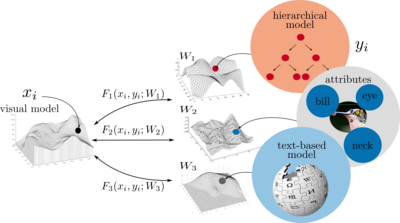
Evaluation of Output Embeddings for Fine-Grained Image Classification
In this work, we show that compelling classification performance can be achieved on fine-grained image sets even without labeled training data. Given image and class embeddings, we learn a compatibility function such that matching embeddings are assigned a higher score than mismatching ones; zero-shot classification of an image proceeds by finding the label yielding the highest joint compatibility score. We use state-of-the-art image features and focus on different supervised attributes and unsupervised output embeddings either derived from hierarchies or learned from unlabeled text corpora.
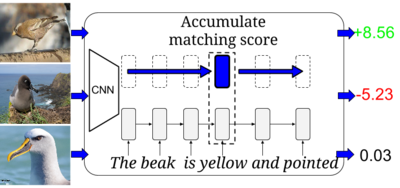
Learning Deep Representations of Fine-Grained Visual Descriptions
Despite good performance, attributes have limitations including (1) finer-grained recognition requires commensurately more attributes; and (2) attributes do not provide a natural language interface. We propose to overcome these limitations by training neural language models from scratch; i.e. without pre-training and only consuming words and characters. Our proposed models train end-to-end to align with the fine-grained and category-specific content of images. Natural language provides a flexible and compact way of encoding only the salient visual aspects for distinguishing categories. By training on raw text our model can do inference on raw text as well, providing humans a familiar mode both for annotation and retrieval.
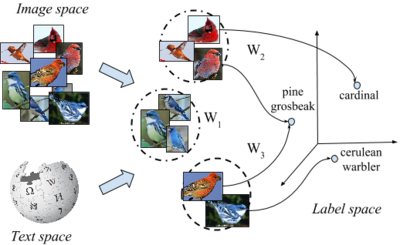
Latent Embeddings for Zero-shot Classification
We present a novel latent embedding model for learning a compatibility function between image and class embeddings, in the context of zero-shot classification. The proposed method augments the state-of-the-art bilinear compatibility model by incorporating latent variables. Instead of learning a single bilinear map, it learns a collection of latent variable maps with the selection of which map to use being a latent variable for the current image-class pair.
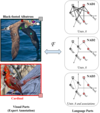
Multi-Cue Zero-Shot Learning with Strong Supervision
The most successful zero-shot learning approaches currently require a particular type of auxiliary information – namely attribute annotations performed by humans – that is not readily available for most classes. Our goal is to circumvent this bottleneck by substituting such annotations by extracting multiple pieces of information from multiple unstructured text sources readily available on the web. To compensate for the weaker form of auxiliary information, we incorporate stronger supervision in the form of semantic part annotations on the classes from which we transfer knowledge.
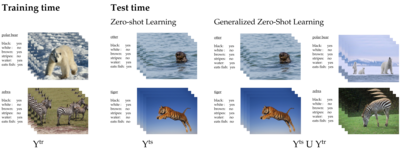
Zero-Shot Learning - The Good, the Bad and the Ugly
Due to the importance of zero-shot learning, the number of proposed approaches has increased steadily recently. We argue that it is time to take a step back and to analyze the status quo of the area. The purpose of this paper is three-fold. First, given the fact that there is no agreed upon zero-shot learning benchmark, we first define a new benchmark by unifying both the evaluation protocols and data splits. This is an important contribution as published results are often not comparable and sometimes even flawed due to, e.g. pre-training on zero-shot test classes. Second, we compare and analyze a significant number of the state-of-the-art methods in depth, both in the classic zero-shot setting but also in the more realistic generalized zero-shot setting. Finally, we discuss limitations of the current status of the area which can be taken as a basis for advancing it.
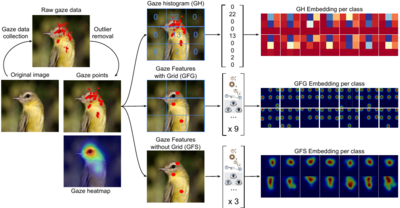
Gaze Embeddings for Zero-Shot Image Classification
Zero-shot image classification using auxiliary information, such as attributes describing discriminative object properties, requires time-consuming annotation by domain experts. We instead propose a method that relies on human gaze as auxiliary information, exploiting that even nonexpert users have a natural ability to judge class membership. We present a data collection paradigm that involves a discrimination task to increase the information content obtained from gaze data. Our method extracts discriminative descriptors from the data and learns a compatibility function between image and gaze using three novel gaze embeddings: Gaze Histograms (GH), Gaze Features with Grid (GFG) and Gaze Features with Sequence (GFS). We introduce two new gaze-annotated datasets for fine-grained image classification and show that human gaze data is indeed class discriminative, provides a competitive alternative to expert annotated attributes, and outperforms other baselines for zero-shot image classification.
Feature Generating Networks for Zero-Shot Learning
Suffering from the extreme training data imbalance between seen and unseen classes, most of existing state-of-the-art approaches fail to achieve satisfactory results for the challenging generalized zero-shot learning task. To circumvent the need for labeled examples of unseen classes, we propose a novel generative adversarial network~(GAN) that synthesizes CNN features conditioned on class-level semantic information, offering a shortcut directly from a semantic descriptor of a class to a class-conditional feature distribution. Our proposed approach, pairing a Wasserstein GAN with a classification loss, is able to generate sufficiently discriminative CNN features to train softmax classifiers or any multimodal embedding method. Our experimental results demonstrate a significant boost in accuracy over the state of the art on five challenging datasets -- CUB, FLO, SUN, AWA and ImageNet -- in both the zero-shot learning and generalized zero-shot learning settings.
f-VAEGAN-D2: A Feature Generating Framework for Any-Shot Learning
When labeled training data is scarce, a promising data augmentation approach is to generate visual features of unknown classes using their attributes. To learn the class conditional distribution of CNN features, these models rely on pairs of image features and class attributes. Hence, they can not make use of the abundance of unlabeled data samples. In this paper, we tackle any-shot learning problems i.e. zero-shot and few-shot, in a unified feature generating framework that operates in both inductive and transductive learning settings. We develop a conditional generative model that combines the strength of VAE and GANs and in addition, via an unconditional discriminator, learns the marginal feature distribution of unlabeled images. We empirically show that our model learns highly discriminative CNN features for five datasets, i.e. CUB, SUN, AWA and ImageNet, and establish a new state-of-the-art in any-shot learning, i.e. inductive and transductive (generalized) zero- and few-shot learning settings. We also demonstrate that our learned features are interpretable: we visualize them by inverting them back to the pixel space and we explain them by generating textual arguments of why they are associated with a certain label.
Semantic Projection Network for Zero- and Few-Label Semantic Segmentation
Semantic segmentation is one of the most fundamental problems in computer vision. As pixel-level labelling in this context is particularly expensive, there have been several attempts to reduce the annotation effort, e.g. by learning from image level labels and bounding box annotations. In this paper we take this one step further and propose zero-and few-label learning for semantic segmentation as a new task and propose a benchmark on the challenging COCO-Stuff and PASCAL VOC12 datasets. In the task of zero-label semantic image segmentation no labeled sample of that class was present during training whereas in few-label semantic segmentation only a few labeled samples were present. Solving this task requires transferring the knowledge from previously seen classes to novel classes. Our proposed semantic projection network (SPNet) achieves this by incorporating class-level semantic information into any network designed for semantic segmentation, and is trained in an end-to-end manner. Our model is effective in segmenting novel classes, i.e. alleviating expensive dense annotations, but also in adapting to novel classes without forgetting its prior knowledge, i.e. generalized zero- and few-label semantic segmentation
